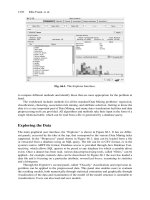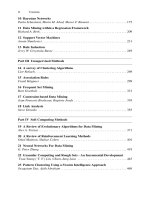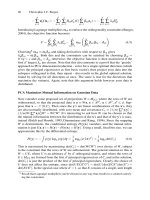Data Mining and Knowledge Discovery Handbook, 2 Edition part 110 docx
Bạn đang xem bản rút gọn của tài liệu. Xem và tải ngay bản đầy đủ của tài liệu tại đây (125.7 KB, 10 trang )
1070
Fig. 56.19. A visualization of the PAA dimensionality reduction technique
mean value of all the data points in segment, and the second number records the length of the
segment.
It is difficult to make any intuitive guess about the relative performance of this technique.
On one hand, PAA has the advantage of having twice as many approximating segments. On the
other hand, APCA has the advantage of being able to place a single segment in an area of low
activity and many segments in areas of high activity. In addition, one has to consider the struc-
ture of the data in question. It is possible to construct artificial datasets, where one approach
has an arbitrarily large reconstruction error, while the other approach has reconstruction error
of zero.
Fig. 56.20. A visualization of the APCA dimensionality reduction technique
In general, finding the optimal piecewise polynomial representation of a time series re-
quires a O(Nn
2
) dynamic programming algorithm (Faloutsos et al., 1997). For most pur-
posed, however, an optimal representation is not required. Most researchers, therefore, use a
greedy suboptimal approach instead (Keogh and Smyth, 1997). In (Keogh et al., 2001), the au-
thors utilize an original algorithm which produces high quality approximations in O(nlog(n)).
The algorithm works by first converting the problem into a wavelet compression problem, for
which there are well-known optimal solutions, then converting the solution back to the APCA
representation and (possible) making minor modification.
Chotirat Ann Ratanamahatana et al.
56 Mining Time Series Data 1071
56.4.7 Symbolic Aggregate Approximation (SAX)
Symbolic Aggregate Approximation is a novel symbolic representation for time series recently
introduced by (Lin et al., 2003), which has been shown to preserve meaningful information
from the original data and produce competitive results for classifying and clustering time
series.
The basic idea of SAX is to convert the data into a discrete format, with a small alpha-
bet size. In this case, every part of the representation contributes about the same amount of
information about the shape of the time series. To convert a time series into symbols, it is first
normalized, and two steps of discretization will be performed. First, a time series T of length
n is divided into w equal-sized segments; the values in each segment are then approximated
and replaced by a single coefficient, which is their average. Aggregating these w coefficients
form the Piecewise Aggregate Approximation (PAA) representation of T . Next, to convert the
PAA coefficients to symbols, we determine the breakpoints that divide the distribution space
into
α
equiprobable regions, where
α
is the alphabet size specified by the user (or it could be
determined from the Minimum Description Length). In other words, the breakpoints are deter-
mined such that the probability of a segment falling into any of the regions is approximately
the same. If the symbols are not equi-probable, some of the substrings would be more probable
than others. Consequently, we would inject a probabilistic bias in the process. In (Crochemore
et al., 1994), Crochemore et al. show that a suffix tree automation algorithm is optimal if the
letters are equiprobable.
Once the breakpoints are determined, each region is assigned a symbol. The PAA coeffi-
cients can then be easily mapped to the symbols corresponding to the regions in which they
reside. The symbols are assigned in a bottom-up fashion, i.e. the PAA coefficient that falls in
the lowest region is converted to “a”, in the one above to “b”, and so forth. Figure 56.21 shows
an example of a time series being converted to string baabccbc. Note that the general shape of
the time series is still preserved, in spite of the massive amount of dimensionality reduction,
and the symbols are equiprobable.
Fig. 56.21. A visualization of the SAX dimensionality reduction technique
To reiterate the significance of time series representation, Figure 56.22 illustrates four of
the most popular representations.
1072
Fig. 56.22. Four popular representations of time series. For each graphic, we see a raw time
series of length 128. Below it, we see an approximation using 1/8 of the original space. In each
case, the representation can be seen as a linear combination of basis functions. For example,
the Discrete Fourier representation can be seen as a linear combination of the four sine/cosine
waves shown in the bottom of the graphics.
Given the plethora of different representations, it is natural to ask which is best. Recall
that the more faithful the approximation, the less clarification disks accesses we will need
to make in Step 3 of Table 56.1. In the example shown in Figure 56.22, the discrete Fourier
approach seems to model the original data the best. However, it is easy to imagine other
time series where another approach might work better. There have been many attempts to
answer the question of which is the best representation, with proponents advocating their fa-
vorite technique (Chakrabarti et al., 2002,Faloutsos et al., 1994,Popivanov et al., 2002,Rafiei
et al., 1998). The literature abounds with mutually contradictory statements such as “Several
wavelets outperform the DFT” (Popivanov et al., 2002), “DFT-base and DWT-based tech-
niques yield comparable results”(Wuet al., 2000), “Haar wavelets perform . . . better than
DFT” (Kahveci and Singh, 2001). However, an extensive empirical comparison on 50 di-
verse datasets suggests that while some datasets favor a particular approach, overall, there is
little difference between the various approaches in terms of their ability to approximate the
data (Keogh and Kasetty, 2002). There are however, other important differences in the usabil-
ity of each approach (Chakrabarti et al., 2002). We will consider some representative examples
of strengths and weaknesses below.
The wavelet transform is often touted as an ideal representation for time series Data Min-
ing, because the first few wavelet coefficients contain information about the overall shape of
Chotirat Ann Ratanamahatana et al.
56 Mining Time Series Data 1073
the sequence while the higher order coefficients contain information about localized trends
(Popivanov et al., 2002, Shahabi et al., 2000). This multiresolution property can be exploited
by some algorithms, and contrasts with the Fourier representation in which every coefficient
represents a contribution to the global trend (Faloutsos et al., 1994, Rafiei et al., 1998). How-
ever, wavelets do have several drawbacks as a Data Mining representation. They are only
defined for data whose length is an integer power of two. In contrast, the Piecewise Constant
Approximation suggested by (Yi and Faloutsos, 2000), has exactly the fidelity of resolution of
as the Haar wavelet, but is defined for arbitrary length time series. In addition, it has several
other useful properties such as the ability to support several different distance measures (Yi
and Faloutsos, 2000), and the ability to be calculated in an incremental fashion as the data
arrives (Chakrabarti et al., 2002). One important feature of all the above representations is
that they are real valued. This somewhat limits the algorithms, data structures, and definitions
available for them. For example, in anomaly detection, we cannot meaningfully define the
probability of observing any particular set of wavelet coefficients, since the probability of ob-
serving any real number is zero. Such limitations have lead researchers to consider using a
symbolic representation of time series (Lin et al., 2003).
56.5 Summary
In this chapter, we have reviewed some major tasks in time series data mining. Since time
series data are typically very large, discovering information from these massive data becomes
a challenge, which leads to the enormous research interests in approximating the data in re-
duced representation. The dimensionality reduction of the data has now become the heart of
time series Data Mining and is the primary step to efficiently deal with Data Mining tasks for
massive data. We review some of important time series representations proposed in the litera-
ture. We would like to emphasize that the key step in any successful time series Data Mining
endeavor always lies in choosing the right representation for the task at hand.
References
Aach, J. and Church, G. Aligning gene expression time series with time warping algorithms.
Bioinformatics; 2001, Volume 17, pp. 495-508.
Aggarwal, C., Hinneburg, A., Keim, D. A. On the surprising behavior of distance metrics in
high dimensional space. In proceedings of the 8th International Conference on Database
Theory; 2001 Jan 4-6; London, UK, pp 420-434.
Agrawal, R., Faloutsos, C., Swami, A. Efficient Similarity Search in Sequence Data bases.
International Conference on Foundations of Data Organization (FODO); 1993.
Agrawal, R., Lin, K I., Sawhney, H.S., Shim, K. Fast Similarity Search in the Presence
of Noise, Scaling, and Translation in Trime-Series Databases. Proceedings of 21
st
In-
ternational Conference on Very Large Databases; 1995 Sep; Zurich, Switzerland, pp.
490-500.
Berndt, D.J., Clifford, J. Finding Patterns in Time Series: A Dynamic Programming Ap-
proach. In Advances in Knowledge Discovery and Data Mining AAAI/MIT Press,
Menlo Park, CA, 1996, pp. 229-248.
Bollobas, B., Das, G., Gunopulos, D., Mannila, H. Time-Series Similarity
Problems and Well-Separated Geometric Sets. Nordic Jour. of Computing 2001; 4.
1074
Brin, S. Near neighbor search in large metric spaces. Proceedings of 21
st
VLDB; 1995.
Chakrabarti, K., Keogh, E., Pazzani, M., Mehrotra, S. Locally adaptive dimensionality reduc-
tion for indexing large time series databases. ACM Transactions on Database Systems.
Volume 27, Issue 2, (June 2002). pp 188-228.
Chan, K., Fu, A.W. Efficient time series matching by wavelets. Proceedings of 15
th
IEEE
International Conference on Data Engineering; 1999 Mar 23-26; Sydney, Australia, pp.
126-133.
Chang, C.L.E., Garcia-Molina, H., Wiederhold, G. Clustering for Approximate Similarity
Search in High-Dimensional Spaces. IEEE Transactions on Knowledge and Data Engi-
neering 2002; Jul – Aug, 14(4): 792-808.
Chiu, B.Y., Keogh, E., Lonardi, S. Probabilistic discovery of time series motifs. Proceedings
of ACM SIGKDD; 2003, pp. 493-498.
Ciaccia, P., Patella, M., Zezula, P. M-tree: An efficient access method for similarity search in
metric spaces. Proceedings of 23
rd
VLDB; 1997, pp. 426-435.
Crochemore, M., Czumaj, A., Gasjeniec, L, Jarominek, S., Lecroq, T.,
Plandowski, W., Rytter, W. Speeding up two string-matching algorithms. Algorithmica;
1994; Vol. 12(4/5), pp. 247-267.
Dasgupta, D., Forrest, S. Novelty Detection in Time Series Data Using Ideas from Immunol-
ogy. Proceedings of 8
th
International conference on Intelligent Systems; 1999 Jun 24-26;
Denver, CO.
Debregeas, A., Hebrail, G. Interactive interpretation of kohonen maps applied to curves. In
proceedings of the 4
th
Int’l Conference of Knowledge Discovery and Data Mining; 1998
Aug 27-31; New York, NY, pp 179-183.
Faloutsos, C., Jagadish, H., Mendelzon, A., Milo, T. A signature technique for similarity-
based queries. Proceedings of the International Conference on Compression and Com-
plexity of Sequences; 1997 Jun 11-13; Positano-Salerno, Italy.
Faloutsos, C., Ranganathan, M., Manolopoulos, Y. Fast subsequence matching in time-series
databases. In proceedings of the ACM SIGMOD Int’l Conference on Management of
Data; 1994 May 25-27; Minneapolis, MN, pp 419-429.
Ge, X., Smyth, P. Deformable Markov Model Templates for Time-Series Pattern Matching.
Proceedings of 6
th
ACM SIGKDD International Conference on Knowledge Discovery
and Data Mining; 2000 Aug 20-23; Boston , MA, pp. 81-90.
Geurts, P. Pattern extraction for time series classification. Proceedings of Principles of Data
Mining and Knowledge Discovery, 5
th
European Conference; 2001 Sep 3-5; Freiburg,
Germany, pp 115-127.
Goldin, D.Q., Kanellakis, P.C. On Similarity Queries for Time-Series Data: Constraint Spec-
ification and Implementation. Proceedings of the 1
st
International Conference on the
Principles and Practice of Constraint Programming; 1995 Sep 19-22; Cassis, France, pp.
137-153.
Guralnik, V., Srivastava, J. Event detection from time series data. In proceedings of the 5th
ACM SIGKDD Int’l Conference on Knowledge Discovery and Data Mining; 1999 Aug
15-18; San Diego, CA, pp 33-42.
Huhtala, Y., Karkkainen, J, Toivonen, H. Mining for similarities in aligned time series using
wavelet. Data Mining and Knowledge Discovery: Theory, Tools, and Technology, SPIE
Proceedings Series 1995; Orlando, FL, Vol. 3695, pp. 150-160.
Hochheiser, H., Shneiderman,, B. Interactive Exploration of Time-Sereis Data. Proceedings
of 4
th
International conference on Discovery Science; 2001 Nov 25-28; Washington,
DC, pp. 441-446.
Chotirat Ann Ratanamahatana et al.
56 Mining Time Series Data 1075
Indyk, P., Koudas, N., Muthukrishnan, S. Identifying representative trends in massive time
series data sets using sketches. In proceedings of the 26th Int’l Conference on Very Large
Data Bases; 2000 Sept 10-14; Cairo, Egypt, pp 363-372.
Jagadish, H.V., Mendelzon, A.O., and Milo, T. Similarity-Based Queries. Proceedings of
ACM PODS; 1995 May; San Jose, CA, pp. 36-45.
Kahveci, T., Singh, A. Variable length queries for time series data. In proceedings of the 17th
Int’l Conference on Data Engineering; 2001 Apr 2-6; Heidelberg, Germany, pp 273-282.
Kalpakis, K., Gada, D., Puttagunta, V. Distance measures for effective clustering of ARIMA
time-series. Proceedings of the IEEE Int’l Conference on Data Mining; 2001 Nov 29-
Dec 2; San Jose, CA, pp 273-280.
Kanth, K.V., Agrawal, D., Singh, A. Dimensionality reduction for similarity searching in
dynamic databases. Proceedings of ACM SIGMOD International Conference; 1998, pp.
166-176.
Keogh, E. Exact indexing of dynamic time warping. Proceedings of 28
th
Internation Confer-
ence on Very Large Databases; 2002; Hong Kong, pp. 406-417.
Keogh, E., Chakrabarti, K., Mehrotra, S., Pazzani, M. Locally adaptive dimensionality re-
duction for indexing large time series databases. Proceedings of ACM SIGMOD Inter-
national Conference; 2001.
Keogh, E., Chakrabarti, K., Pazzani, M., Mehrotra, S. Dimensionality reduction for fast sim-
ilarity search in large time series databases. Knowledge and Information Systems 2001;
3: 263-286.
Keogh, E., Lin, J., Truppel, W. Clustering of Time Series Subsequences is Meaningless:
Implications for Previous and Future Research. Proceedings of ICDM; 2003, pp. 115-
122.
Keogh, E., Lonardi, S., Chiu, W. Finding Surprising Patterns in a Time Series Database In
Linear Time and Space. In the 8
th
ACM SIGKDD International Conference on Knowl-
edge Discovery and Data Mining; 2002 Jul 23 – 26; Edmonton, Alberta, Canada, pp
550-556.
Keogh, E., Lonardi, S., Ratanamahatana, C.A. Towards Parameter-Free Data Mining. Pro-
ceedings of 10
th
ACM SIGKDD International Conference on Knowledge Discovery and
Data Mining; 2004 Aug 22-25; Seattle, WA.
Keogh, E., Pazzani, M. An enhanced representation of time series which allows fast and
accurate classification, clustering and relevance feedback. Proceedings of the 4
th
Int’l
Conference on Knowledge Discovery and Data Mining; 1998 Aug 27-31; New York,
NY, pp 239-241.
Keogh, E. and Kasetty, S. On the Need for Time Series Data Mining Benchmarks: A Survey
and Empirical Demonstration. In the 8th ACM SIGKDD International Conference on
Knowledge Discovery and Data Mining; 2002 Jul 23 – 26; Edmonton, Alberta, Canada,
pp 102-111.
Keogh, E., Smyth, P. A Probabilistic Approach to Fast Pattern matching in
Time Series Databases. Proceedings of 3
rd
International conference on
Knowledge Discovery and Data Mining; 1997 Aug 14-17; Newport Beach, CA,
pp. 24-30.
Korn, F., Jagadish, H., Faloutsos, C. Efficiently supporting ad hoc queries in large datasets of
time sequences. Proceedings of SIGMOD International Conferences 1997; Tucson, AZ,
pp. 289-300.
Kruskal, J.B., Sankoff, D., Editors. Time Warps, String Edits, and Macromolecules: The
Theory and Practice of Sequence Comparison. Addison-Wesley, 1983.
1076
Lin, J., Keogh, E., Lonardi, S., Chiu, B. A Symbolic Representation of Time Series, with
Implications for Streaming Algorithms. Workshop on Research Issues in Data Mining
and Knowledge Discovery, 8
th
ACM SIGMOD; 2003 Jun 13; San Diego, CA.
Lin, J., Keogh, E., Lonardi, S., Lankford, J. P., Nystrom, D. M. Visually Mining and Moni-
toring Massive Time Series. Proceedings of the 10
th
ACM SIGKDD International Con-
ference on Knowledge Discovery and Data Mining; 2004 Aug 22-25; Seattle, WA.
Ma, J., Perkins, S. Online Novelty Detection on Temporal Sequences. Proceedings of 9
th
International Conference on Knowledge Discovery and Data Mining; 2003 Aug 24-27;
Washington DC.
Nievergelt, H., Hinterberger, H., Sevcik, K.C. The grid file: An adaptable, symmetricmulti-
key file structure. ACM Trans. Database Systems; 1984; 9(1): 38-71.
Palpanas, T., Vlachos, M., Keogh, E., Gunopulos, D., Truppel, W. Online
Amnestic Approximation of Streaming Time Series. Proceedings of 20
th
International
Conference on Data Engineering; 2004, Boston, MA.
Pavlidis, T., Horowitz, S. Segmentation of plane curves. IEEE Transactions on Computers;
1974 August; Vol. C-23(8), pp. 860-870.
Popivanov, I., Miller, R. J. Similarity search over time series data using wave
-lets. In proceedings of the 18
th
Int’l Conference on Data Engineering; 2002 Feb 26-Mar
1; San Jose, CA, pp 212-221.
Rafiei, D., Mendelzon, A. O. Efficient retrieval of similar time sequences using DFT. In
proceedings of the 5
th
Int’l Conference on Foundations of Data Organization and Algo-
rithms; 1998 Nov 12-13; Kobe, Japan.
Ratanamahatana, C.A., Keogh, E. Making Time-Series Classification More Accurate Using
Learned Constrints. Proceedings of SIAM International
Conference on Data Mining; 2004 Apr 22-24; Lake Buena Vista, FL, pp.11-22.
Ripley, B.D. Pattern recognition and neural networks. Cambridge University Press, Cam-
bridge, UK, 1996.
Robinson, J.T. The K-d-b-tree: A search structure for large multidimensional dynamic in-
dexes. Proceedings of ACM SIGMOD; 1981.
Shahabi, C., Tian, X., Zhao, W. TSA-tree: a wavelet based approach to improve the efficiency
of multi-level surprise and trend queries. In proceedings of the 12
th
Int’l Conference on
Scientific and Statistical Database Management; 2000 Jul 26-28; Berlin, Germany, pp
55-68.
Struzik, Z., Siebes, A. The Haar wavelet transform in the time series similarity paradigm.
Proceedings of 3
rd
European Conference on Principles and Practice of Knowledge Dis-
covery in Databases; 1999; Prague, Czech Republic, pp. 12-22.
Tufte, E. The visual display of quantitative information. Graphics Press,
Cheshire, Connecticut, 1983.
Tzouramanis, T., Vassilakopoulos, M., Manolopoulos, Y. Overlapping Linear Quadtrees: A
Spatio-Temporal Access Method. ACM-GIS; 1998, pp. 1-7.
Guralnik, V., Srivastava, J. Event Detection from Time Series Data. Proceedings of ACM
SIGKDD; 1999, pp 33-42.
Vlachos, M., Gunopulos, D., Das, G. Rotation Invariant Distance Measures for Trajecto-
ries. Proceedings of 10
th
International Conference on Knowledge Discovery and Data
Mining; 2004 Aug 22-25; Seattle, WA.
Vlachos, M., Meek, C., Vagena, Z., Gunopulos, D. Identification of Similarities, Periodic-
ities & Bursts for Online Search Queries. Proceedings of International Conference on
Management of Data; 2004; Paris, France.
Chotirat Ann Ratanamahatana et al.
56 Mining Time Series Data 1077
Weber, M., lexa, M., Muller, W. Visualizing Time Series on Spirals. Proceedings of IEEE
Symposium on Information Visualization; 2000 Oct 21-26; San Diego, CA, pp. 7-14.
Wijk, J.J. van, E. van Selow. Cluster and calendar-based visualization of time series data.
Proceedings of IEEE Symposium on Information Visualization; 1999 Oct 25-26, IEEE
Computer Society, pp 4-9.
Wu, D., Agrawal, D., El Abbadi, A., Singh, A, Smith, T.R. Efficient retrieval for brows-
ing large image databases. Proceedings of 5
th
International Conference on Knowledge
Information; 1996; Rockville, MD, pp. 11-18.
Wu, Y., Agrawal, D., El Abbadi, A. A comparison of DFT and DWT based similarity search
in time-series databases. In proceedings of the 9
th
ACM CIKM Int’l Conference on
Information and Knowledge Management; 2000 Nov 6-11; McLean, VA, pp 488-495.
Yi, B., Faloutsos, C. Fast time sequence indexing for arbitrary lp norms. Proceedings of
the 26th Int’l Conference on Very Large Databases; 2000 Sep 10-14; Cairo, Egypt, pp
385-394.
Yianilos, P. Data structures and algorithms for nearest neighbor search in general metric
spaces. Proceedings of 3
rd
SIAM on Discrete Algorithms; 1992.
Zhu, Y., Shasha, D. StatStream: Statistical Monitoring of Thousands of Data Streams in Real
Time, Proceedings of VLDB; 2002, pp. 358-369.
Part VII
Applications









